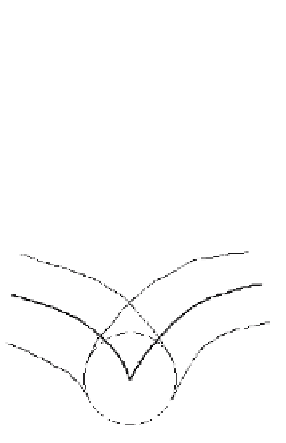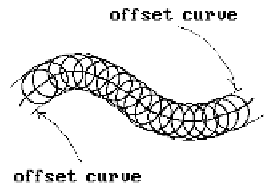Graphics Reference
In-Depth Information
segment in a suitable way, say by some polygonal curves. One is not yet done though
because trimming needs to be done if there are self-intersections in the offset curve.
This involves first finding the intersection points, an interesting problem in its own
right, and then trimming the segments between them. See [FarN90a]. One is then
finally ready to generate an appropriate path for the NC machine.
Another approach to getting offset curves is suggested by how milling machines
work. One rolls a circle of radius d along the curve. This will sweep out a solid region
and the offset curve is one of the boundaries of that region. See Figure 14.39. Now
the circle of radius d centered at p(u) can be parameterized by
()
=
()
+
(
)
jq
p u
d cos ,sin
q
q
.
(14.33)
The points on the offset curve are therefore those at which the tangent line to j(q) is
parallel to the tangent line at p(u) = (x(u),y(u)). In other words, we are looking for
those points at which
(
)
=¢
()
¢
()
(
)
-
sin ,cos
qqcx u y u
,
,
(14.34)
that is,
¢
()
¢
()
xu
yu
tan
q=-
.
One has to worry about those places where y¢(u) is zero, in particular, where there are
cusps. See Figure 14.40.
The fact that equations (14.33) and (14.34) involve transcendental functions may
not be desirable. Therefore, one may want to reformulate the envelope into a poly-
nomial form by introducing two variables s and t as follows:
Figure 14.39.
Offset curves from milling machine.
Figure 14.40.
A milling machine offset curve problem.




